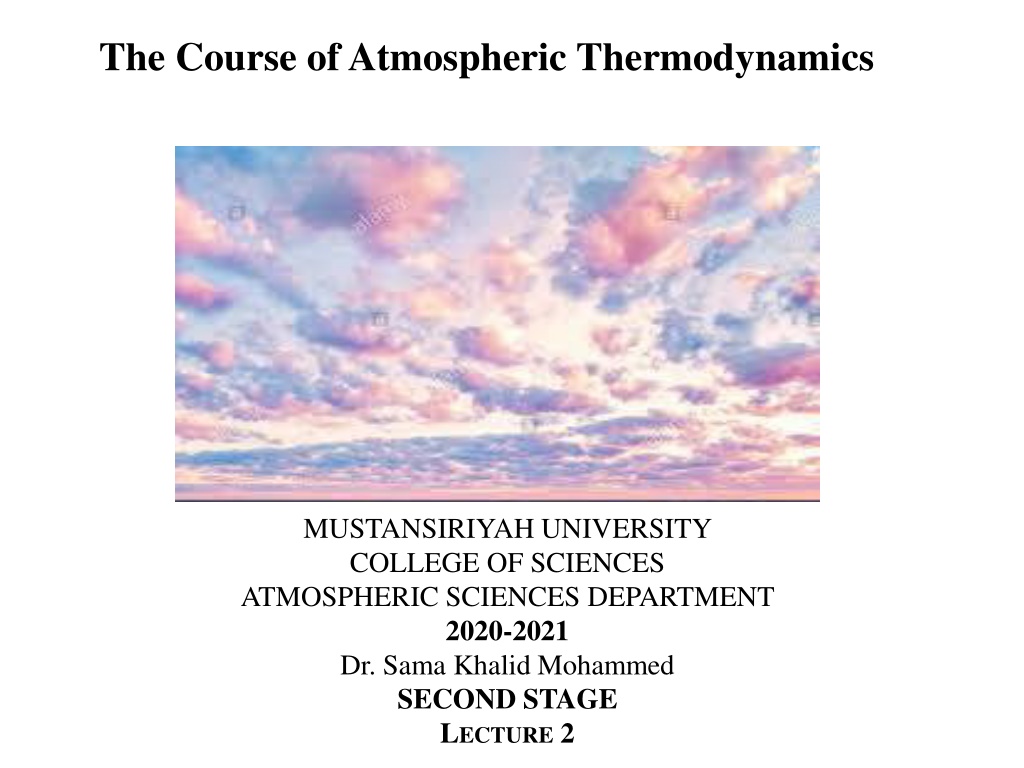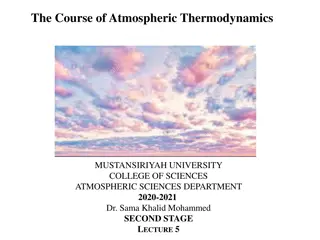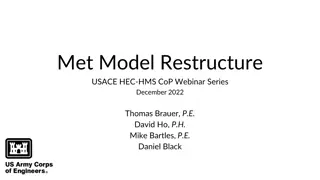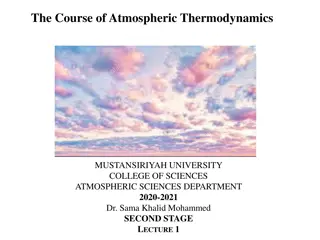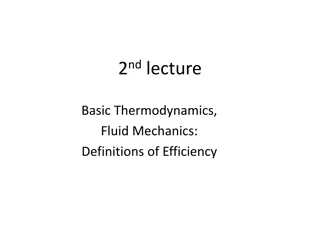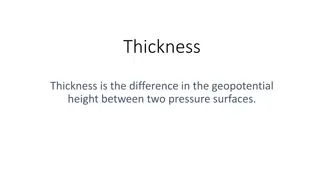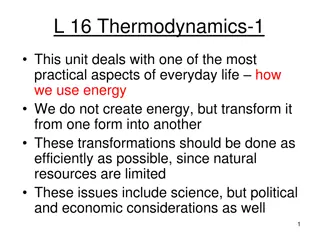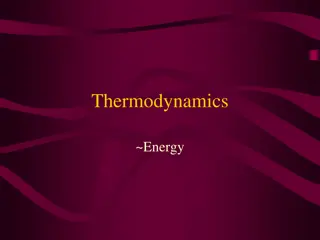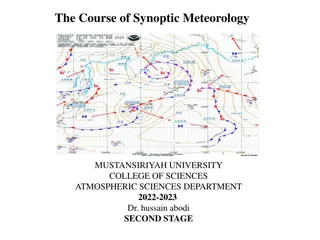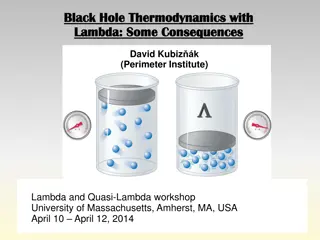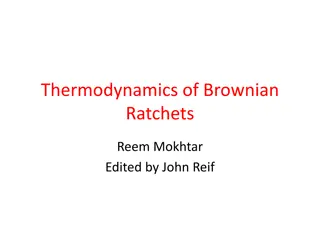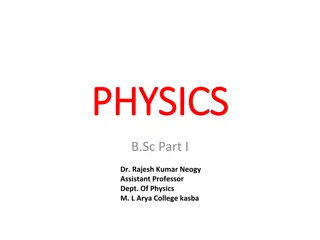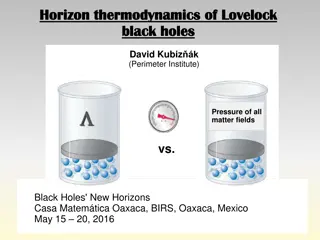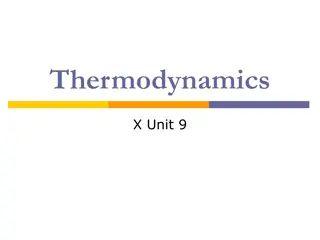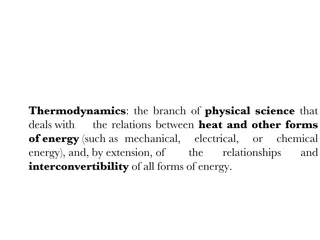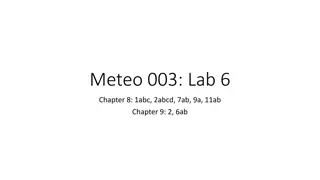Understanding Atmospheric Thermodynamics in Meteorology
Explore the fundamentals of atmospheric thermodynamics including dry air properties, dry adiabatic lapse rate, moist air components, and saturated adiabatic lapse rate. Delve into concepts like dew point temperature, relative humidity, and wet bulb temperature to gain insight into air behavior in various conditions.
Download Presentation

Please find below an Image/Link to download the presentation.
The content on the website is provided AS IS for your information and personal use only. It may not be sold, licensed, or shared on other websites without obtaining consent from the author. Download presentation by click this link. If you encounter any issues during the download, it is possible that the publisher has removed the file from their server.
E N D
Presentation Transcript
The Course of Atmospheric Thermodynamics MUSTANSIRIYAH UNIVERSITY COLLEGE OF SCIENCES ATMOSPHERIC SCIENCES DEPARTMENT 2020-2021 Dr. Sama Khalid Mohammed SECOND STAGE LECTURE 2
THIS LECTURE INCLUDING THE FOLLOWING ITEMS DRY AIR DRYADIABATIC LAPSE RATE MOIST AIR PARTIAL PRESSURE VAPOR PRESSURE SATURATION VAPOR PRESSURE SPECIFIC HUMIDITY AND MIXING RATIO DEW POINT TEMPERATURE RELATIVE HUMIDITY WET BULB TEMPERATURE VIRTUAL TEMPERATURE
Dry Air Definition In meteorology, there are two ways in which dry air is referenced: A sample of air that has no water vapor (The amount of water vapor in the air depends on the dewpoint of the air). A sample of air that has a low relative humidity At a temperature of 30 C with a relative humidity (RH) of 50% the dew point is 18.45 C. For drier air with temperature of 30 C and RH of 20 the dew point is 4.61 C.
DRY ADIABATIC LAPSE RATE This formula says that if you lift an air parcel adiabatically, its temperature will decrease, which makes physical sense because the parcel will be expanding.
MOIST AIR In atmospheric thermodynamics, moist air is a mixture of dry air and any amount of water vapor. There are many expressions that can be used for moist air and they are: Vapor Pressure Absolute Humidity Specific Humidity Mixing ratio Dew point Temperature Relative humidity Wet Bulb Temperture
The Saturated Adiabatic Lapse Rate When the parcel of air reaches the Dew Point and becomes saturated, water vapor condenses, latent heat is released during the condensation process, which warms the air, and the lapse rate reduces. The Saturated Adiabatic Lapse Rate s is therefore the rate at which saturated air cools with height. In contrast to the dry adiabatic lapse rate d, which is constant, the numerical value of the saturated adiabatic lapse rate s varies with pressure and temperature, and s < d. Actual values of s range from about 4 K/km near the ground in warm, humid air masses to typical values of 6-7 K/km in the middle troposphere.
PARTIAL PRESSURE In a mixture of gases, each gas species contributes to the total pressure. The pressure exerted by a single gas species is known as the partial pressure for that species. For a mixture of ideal gases, the partial pressure of any species can be found from the ideal gas law applied to that species only. For example, in air the partial pressures of O2, N2, and Ar would be The densities used in the above equations are partial densities.
PARTIAL PRESSURE The total pressure is equal to the sum of the partial pressures, and the total density is equal to the sum of the partial densities. The partial pressure of a species is proportional to the number of moles of the species, and can be found by multiplying the total pressure by the volume (or mole) fraction of the species. For example, the partial pressure of O2 is found by multiplying atmospheric pressure by 0.21 (21%).
VAPOR PRESSURE If you have a substance in liquid form, some of the molecules will escape into the vapor phase. The partial pressure due to these vapor molecules is known as the vapor pressure. Since the vapor pressure due to water molecules is proportional to the number of water vapor molecules in the atmosphere, vapor pressure is one measure of humidity, we usually denote vapor pressure as e Absolute humidity is defined as the mass of water vapor per unit volume. It is merely the density of the water vapor, v Vapor pressure is related to absolute humidity via the ideal gas law, e = v Rv T , where Rv is the specific gas constant for water vapor (461 J/kg K). The higher the amount of water vapor, the higher the absolute humidity.
SATURATION VAPOR PRESSURE The vapor molecules are colliding with each other. Some may stick together briefly to form tiny water droplets. However, these tiny water droplets are also constantly breaking apart. If enough vapor molecules are present, there may be enough collisions to form a stable population of liquid water droplets. This is called saturation, and the vapor pressure at this point is called the saturation vapor pressure (es).
SATURATION VAPOR PRESSURE The saturation vapor pressure is a function of temperature, and is given by the Clausius-Clapeyron equation Note that e0 is the same as e where e0 is the vapor pressure at some known temperature T0, and L is the latent heat of vaporization. We typically use T0 = 273K, e0 = 611 Pa, and Lv = 2.5x106 J/kg. Riddles Heat energy (released /taken) in .. (evaporation/condensation) ..(from/into) the environment. SVP (saturation vapor pressure) Curve
SPECIFIC HUMIDITY AND MIXING RATIO Vapor pressure and absolute humidity are not very convenient expressions for humidity (at least for meteorologists). We define some other measures of humidity. Mixing ratio: The mass of water vapor per mass of dry air. This would be dimensionless (if expressed as kg/kg, or g/g). However, it is more often expressed as grams of water vapor per kg of dry air, so the units of mixing ratio are usually expressed as g/kg. Mixing ratio can be related to vapor pressure via where = Rd/Rv. P=Pd +e The saturation mixing ratio, rs, is found by using es in the formula.
SPECIFIC HUMIDITY AND MIXING RATIO The saturation mixing ratio (rs) is the ratio of the mass of water vapor (Mv) to the mass of dry air (Md) in a parcel of air at saturation. In other words rs is the maximum amount of water vapor that a parcel can hold without condensation. rs = Mv / Md The saturation mixing ratio is expressed in grams of water vapor per kilogram of dry air.
SPECIFIC HUMIDITY AND MIXING RATIO Specific humidity: The mass of water vapor per mass of air, it is very close to mixing ratio, since r << 1 (expressed as g/g or kg/kg). as shown in the following equation In meteorology, mixing ratio is used far more than specific humidity, and for most purposes the two can be considered as equivalent. Absolute and specific humidity are quite similar in concept, explain?
DEW POINT TEMPERATURE The saturation vapor pressure is a function of temperature, and decreases with decreasing temperature. If you cool moist air, eventually the saturation vapor pressure will equal the vapor pressure, and saturation will be reached. The temperature at which this occurs is called the dew point, or dew point temperature. The dew point temperature can be found from the Clausius- Clapeyron equation by using the actual vapor pressure instead of the saturation vapor pressure, and solving for T. This gives
RELATIVE HUMIDITY Relative humidity, as its name implies, is a relative measure of humidity. It is defined as the ratio of the vapor pressure to the saturation vapor pressure, RH = e 100 * % se In terms of mixing ratio, relative humidity becomes ?? 100%=? ? ?? ?? This means we can use mixing ratio rather than vapor pressure to find relative humidity. Relative humidity (RH) (expressed as a percent) also measures water vapor, but RELATIVE to the temperature of the air.
Wet Bulb Temperature Tw Meteorologists commonly measure humidity by measuring the wet-bulb temperature. The wet-bulb temperature is the lowest temperature that can be achieved by evaporating water into the air parcel at constant pressure (the evaporation requires heat, which is supplied by the air parcel). It is measured using A PSYCHROMETER.
Wet Bulb Depression The difference between the air temperature (dry-bulb temperature) and the wet-bulb temperature is called WET-BULB DEPRESSION The wet-bulb depression is a relative measure of the moisture content of the air. Dry air can be cooled much further by evaporation than moist air, so a larger wet-bulb depression means less humidity (for the same dry-bulb temperature). The dew-point temperature and relative humidity are found by using psychrometric tables, with dry-bulb temperature and wet- bulb depression as the independent variables.
VIRTUAL TEMPERATURE Moist air can be considered a mixture of two ideal gases (dry air and water vapor). The ideal gas law for moist air is By manipulate the above equation , we can define a new temperature, Tv ( the virtual temperature) For moist air we can use the ideal gas law for dry air, only using the virtual temperature in place of the actual temperature. The virtual temperature is the temperature that dry air would have if its pressure and density were equal to those of a given sample of moist air , and it can be expressed as: Tv= (1 + 0.61 q ) T Virtual temperature is always greater than or equal to the actual temperature.
VIRTUAL TEMPERATURE The addition of water vapor causes the air to behave as though it is warmer. This makes sense, because moist air is lighter than dry air. we can write virtual temperature using mixing ratio as Tv (1 + 0.61 r ) In all of the preceding equations for virtual temperature we must use the absolute (Kelvin) temperature and the dimensionless form of mixing ratio or specific humidity. However, there is an approximate formula for virtual temperature in Celsius that uses the dimensional (g/kg) form of mixing ratio or specific humidity. This formula is Tv ( C ) T ( C) +r (g/kg) 6
